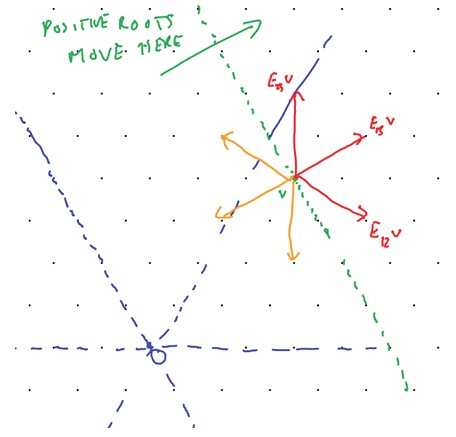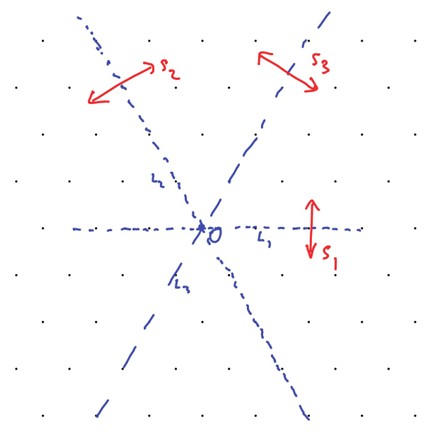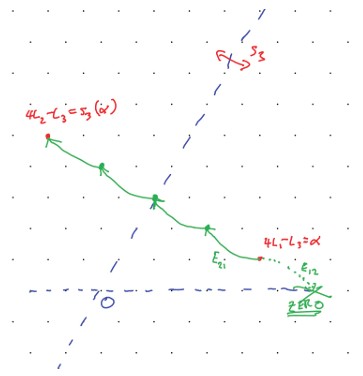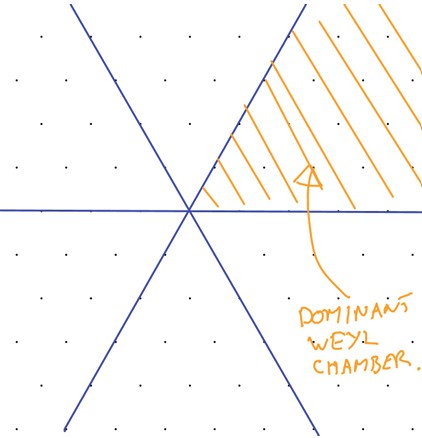4.19. Lecture 19
4.19.1. Highest weights
We now develop the theory of highest weights, analogous to that for . We first carry out the fundamental weight calculation (the analogue of Lemma 3.13.1).
Lemma 4.19.1.
(Fundamental Weight Calculation). Let be a representation of and let be a weight vector with weight . Let be a root and let be a root vector. Then
Thus we obtain a map
Proof.
Let . Then
Example 4.19.2.
We work this out for the adjoint representation. Recall that, for , we have the root with root vector . The above calculation shows that, if and are roots, then . Here are some examples:
-
(i)
If , , then is not a root so . Thus (which could also be checked directly).
-
(ii)
If then we get
-
(iii)
If , , then and we get
In fact, you can check that .
Corollary 4.19.3.
Let be a finite-dimensional irreducible representation of . Then the weights occurring in all differ by integral linear combinations of the roots of , that is, by integral linear combinations of .
Proof.
Let be any weight of . Then the weights obtained by (repeatedly) applying elements of differ by integral linear combinations of the roots. On the other hand this also gives an invariant subspace, which by irreducibility is all of . ∎
With regard to the weight diagram, we observe that the positive root vectors , , move in the ‘north-east’ direction while the negative root vectors move in the ‘south-west’ direction (roughly speaking). See Figure 4.3.

Definition 4.19.4.
Let be a representation of . A highest weight vector in is a vector such that:
-
(i)
is a weight vector; and
-
(ii)
.
The weight of is then a highest weight for .
Remark 4.19.5.
Since , it follows also that for a highest weight vector. So all positive root vectors send to .
Example 4.19.6.
-
(i)
The standard representation has highest weight with highest weight vector .
-
(ii)
The dual has highest weight with highest weight vector .
-
(iii)
The adjoint representation has highest weight with highest weight vector .
-
(iv)
The symmetric square has highest weight with highest weight vector .
Lemma 4.19.7.
Let be a finite-dimensional representation of . Then has a highest weight vector.
Proof.
For a weight , define . Of all the finitely many weights of , choose a weight such that is maximal.
Let be a weight vector with this weight. Then , if non-zero, has weight and
This is not a weight of by maximality of . Thus . Similarly , if non-zero, has weight and , so . ∎
4.19.2. Weyl symmetry
Let , , and be, respectively, reflections in the lines through , , and . Then any two of these (say and ) generate the Weyl group , which is the group of symmetries of the triangle with vertices . So we have . Note that acts on the plane in a way that preserves the weight lattice. See Figure 4.4.

Theorem 4.19.8.
Let be a finite-dimensional representation of . Then the weights of are symmetric with respect to the action of the Weyl group.
Proof.
We will prove they are symmetric with respect to by using the inclusion
that puts a matrix in the top left corner of a matrix. We consider the restriction of to .
Note that if is a weight vector with weight , then
Thus is an -weight vector with weight . Note that , so an -weight vector in is an -highest weight vector if it is sent to under the action of .
The kernel of on is preserved by (check this, Problem 4.19.3) and so has a basis made up of -weight vectors . These are then a maximal set of linearly independent highest weight vectors for and in particular, if is the -representation generated by then, as an -representation,
Fix ; it suffices to show that has a basis of -weight vectors whose weights are preserved by . Let have weight . It follows from the -theory that and — remembering that — that has a basis
By the FWC (Lemma 4.19.1) we see that these are weight vectors with weights
which are symmetrical under (this reflection swaps and ), as required. This argument is illustrated in Figure 4.5.
Invariance with respect to the other reflections is proved similarly using the other inclusions of in . ∎

Corollary 4.19.9.
Every highest weight is of the form for integers.
Proof.
Indeed, in the course of the proof of Theorem 4.19.8 we showed that if was a highest weight, then . A similar argument shows that . ∎
Definition 4.19.10.
The region
is called the dominant Weyl chamber and weights inside it (including the boundary) are dominant weights.

4.19.3. Exercises
Problem 54. Show that the kernel of is preserved by .
Problem 55. Let is a representation of . As is simply-connected exponentiates to a representation, , of . Let
-
(i)
Show that, for every weight , is an isomorphism
Here .
-
(ii)
Give another proof of Theorem 4.19.8.
Problem 56. Let be integers. Check that
is a highest weight vector with weight .